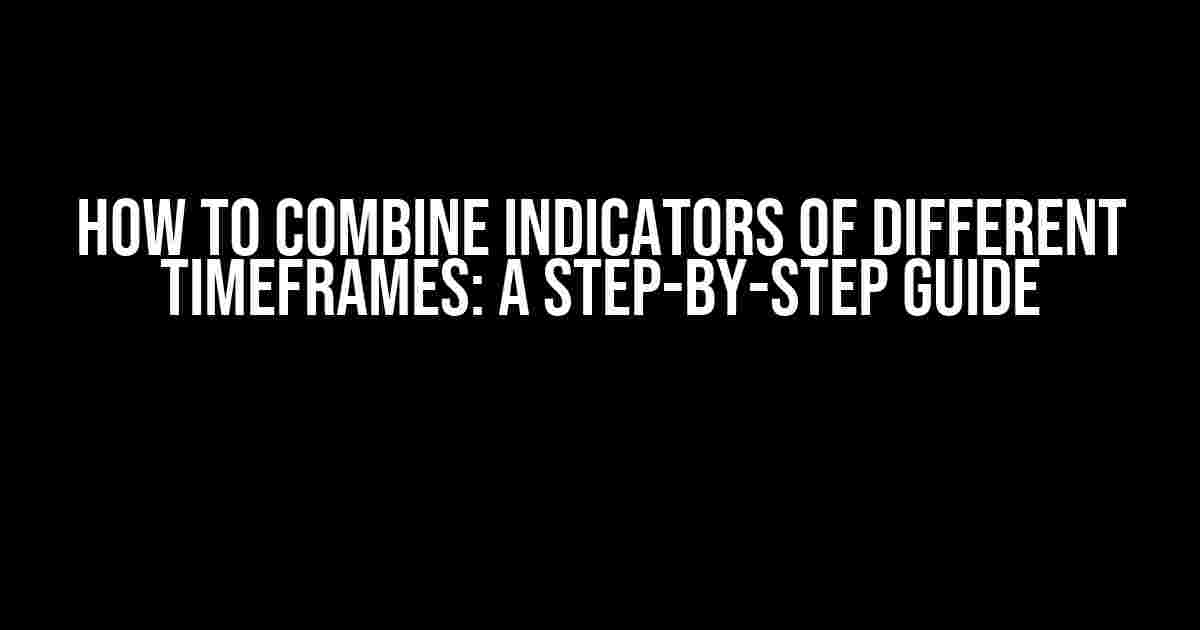Are you tired of relying on a single indicator to make trading decisions? Do you want to take your technical analysis to the next level? Combining indicators of different timeframes is the answer! In this article, we’ll show you how to do just that, providing a comprehensive guide on how to create a robust trading strategy that incorporates multiple indicators across various timeframes.
Why Combine Indicators of Different Timeframes?
Before we dive into the how-to, let’s discuss the why. Combining indicators of different timeframes offers several benefits, including:
- Improved accuracy: By combining multiple indicators, you can reduce the likelihood of false signals and increase the accuracy of your trading decisions.
- Enhanced risk management: Using indicators from different timeframes helps you identify potential risks and adjust your trading strategy accordingly.
- Increase in confidence: With a more comprehensive view of the market, you’ll feel more confident in your trading decisions, leading to better performance.
Choosing the Right Indicators
The first step in combining indicators of different timeframes is to choose the right indicators. You’ll want to select indicators that:
- Measure different aspects of the market (e.g., trend, momentum, volatility)
- Have different timeframes (e.g., short-term, medium-term, long-term)
- Are not highly correlated (to avoid duplication of signals)
Some popular indicator combinations include:
| Indicator 1 | Indicator 2 | Indicator 3 |
|---|---|---|
| Short-term RSI (14-period) | Medium-term MACD (12,26) | Long-term Moving Average (200-period) |
| Bollinger Bands (20,2) | Stochastic Oscillator (14,3) | Ichimoku Cloud |
Setting Up Your Indicators
Once you’ve chosen your indicators, it’s time to set them up on your chart. Here’s an example using the first combination:
// Short-term RSI (14-period)
rsiShort = RSI(close, 14)
// Medium-term MACD (12,26)
macdMedium = MACD(close, 12, 26)
// Long-term Moving Average (200-period)
maLong = SMA(close, 200)
Combining the Indicators
Now that you have your indicators set up, it’s time to combine them. There are several ways to do this, including:
Signal-based approach
In this approach, you create a trading strategy based on the signals generated by each indicator. For example:
// Buy signal: RSI crosses above 30, MACD crosses above signal line, and price above 200-period MA
buySignal = crossover(rsiShort, 30) and crossover(macdMedium, macdMedium.signal) and close > maLong
// Sell signal: RSI crosses below 70, MACD crosses below signal line, and price below 200-period MA
sellSignal = crossover(rsiShort, 70) and crossover(macdMedium, macdMedium.signal) and close < maLong
Weighted approach
In this approach, you assign weights to each indicator based on its importance and then calculate a composite score. For example:
// Assign weights to each indicator (e.g., 30% for RSI, 40% for MACD, 30% for MA)
weightRSI = 0.3
weightMACD = 0.4
weightMA = 0.3
// Calculate the composite score
compositeScore = (rsiShort * weightRSI) + (macdMedium * weightMACD) + (maLong * weightMA)
// Buy signal: Composite score above a certain threshold (e.g., 0.6)
buySignal = compositeScore > 0.6
// Sell signal: Composite score below a certain threshold (e.g., 0.4)
sellSignal = compositeScore < 0.4
Tips and Tricks
Here are some additional tips to keep in mind when combining indicators of different timeframes:
- Use multiple timeframes for each indicator: This helps to reduce noise and False signals.
- Adjust the weights and thresholds: Experiment with different weights and thresholds to find the optimal combination for your trading strategy.
- Monitor and adjust: Continuously monitor your trading strategy and adjust the indicators and weights as needed.
- Combine with other forms of analysis: Incorporate fundamental analysis, news, and market sentiment to create a more comprehensive trading strategy.
Conclusion
Combining indicators of different timeframes is a powerful way to enhance your trading strategy. By following the steps outlined in this guide, you can create a robust trading system that incorporates multiple indicators across various timeframes. Remember to experiment, monitor, and adjust your strategy to optimize your results. Happy trading!
Frequently Asked Question
Get ready to merge the power of multiple timeframes and elevate your trading game! Here are the most frequently asked questions about combining indicators of different timeframes.
What's the purpose of combining indicators of different timeframes?
Combining indicators of different timeframes helps traders identify patterns, trends, and signals that might be hidden when looking at a single timeframe. It's like having multiple pairs of eyes on the market, providing a more comprehensive view and increasing the accuracy of trading decisions.
How do I choose the right timeframes to combine?
Selecting the right timeframes depends on your trading strategy, risk tolerance, and market conditions. A common approach is to combine short-term (15-minute, 1-hour) and long-term (4-hour, daily) timeframes. This allows you to capture short-term volatility while considering the broader market trend.
What are some popular indicator combinations for different timeframes?
Some popular combinations include pairing the Relative Strength Index (RSI) on a 15-minute chart with a Moving Average Convergence Divergence (MACD) on a 4-hour chart, or using the Bollinger Bands on a 1-hour chart alongside a Stochastic Oscillator on a daily chart. Experiment with different combinations to find what works best for you!
How do I avoid false signals when combining indicators of different timeframes?
To minimize false signals, focus on confluence – when multiple indicators on different timeframes are signaling the same thing. Be cautious of conflicting signals, and consider using filters, such as a momentum indicator, to validate trade entries. Always keep your risk management strategy in check!
Can I use this approach with any type of trading strategy?
Absolutely! Combining indicators of different timeframes can be applied to various trading strategies, including trend following, mean reversion, and breakout trading. It's essential to understand how the indicators interact with each other and adapt the approach to your specific strategy and market conditions.
